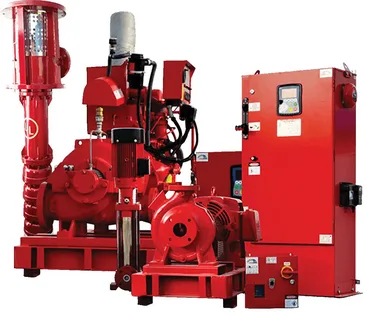A fire fighting pump is a tool that’s used to increase the water pressure (measured in psi and bar) in your sprinkler system when your existing water source can’t meet demand. The pump is usually installed on a trailer and can be transported to the scene of an incident by firefighters or by home owners. The pump increases the water pressure by creating a vacuum in a suction line and using the resulting head to push the water through a discharge line at high volume. The increased water pressure helps to make your fire suppression systems more effective. The pump is typically powered by either gasoline or diesel engines. Angus Fire has a full range of portable fire pumps with petrol or diesel powered engines, all designed to be compact, lightweight and reliable. They are air-cooled, use an oil bath seal and are designed to meet world wide regulatory requirements.
Trans portable fire fighting pump are typically built on a frame and consist of a pump end that is flanged to the motor. Some models are built as an integrated part of the firefighting vehicle while others are made as a portable unit.
Centrifugal fire pumps are the most common type of fire pump. They have a large diameter impeller with a narrow rim. As water enters the suction inlet, the impeller rotates and drives it to the rim where it discharges. The rotation of the impeller generates a large amount of pressure in the suction and discharge lines. The pumps are designed to withstand the large volumes and high pressures that they are required to deliver.
High-pressure water pumps are also a common type of fire pump that is sometimes used in sprinkler system applications. These pumps are designed to provide long distance hose lays or high elevation areas with the required pressure for water distribution. They can be powered by electricity, gasoline or diesel engines depending on the availability of power sources and the application requirements.
Water and fire pumps are designed for different purposes, so the pumping mechanisms are very different. Fire pumps are centrifugal and can be powered by either gasoline or diesel fuel, while water pumps can be powered by any of these, as well as by electricity. Water pumps are more commonly used for non-firefighting purposes such as irrigation or water supply.
It’s important to consult a certified fire protection specialist to determine the proper size and capacity of your fire fighting pumps for your sprinkler system. NFPA has specific regulations on installing, testing and maintaining these types of systems. The pump must be sized to match the hydraulic design of the system it will serve. The pump should also be tested periodically for any malfunctions that may occur over time. The pump should be reprimered as needed in order to maintain an adequate working pressure. In addition to being able to handle the load of water that will be pumped, the fire pump must start reliably.
